
Big Bang to Civilization: 10 Amazing Origin Events
Big Bang to Civilization: 10 Amazing Origin Events (Op-Ed)
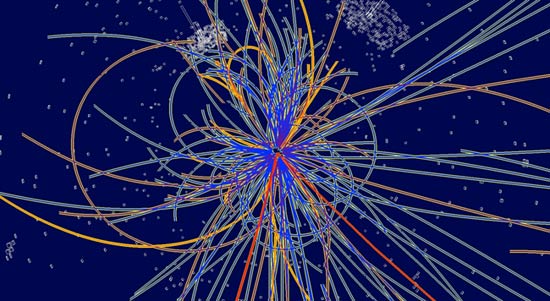
Roger Briggs is the author of "Journey to Civilization: The Science of How We Got Here" (Collins Foundation Press, 2013). In his book, he presents a new creation story of the universe, the Earth, life and humanity based on the evidence and skepticism of science. Briggs contributed this article to LiveScience's Expert Voices: Op-Ed & Insights.
One of the unheralded achievements of modern science is that it can now provide a coherent origin story for humanity, something that was not possible just a few decades ago. With new discoveries in astrophysics, evolutionary biology, molecular genetics, geology and paleoanthropology, a continuous story has emerged starting from the Big Bang. This is both a new cosmology that humanity is embedded in, and a grand tour of science. Here is one science-lover's top 10 list of the coolest science underlying the human origin story, in chronological order.
There is so much I left out — for more, see "Journey to Civilization: The Science of How We Got Here" (Collins Foundation Press, 2013) and As Myth Marries Science, the Origin Story Matters(Op-Ed).
The Big Flash: Origin of the Cosmic Background Radiation
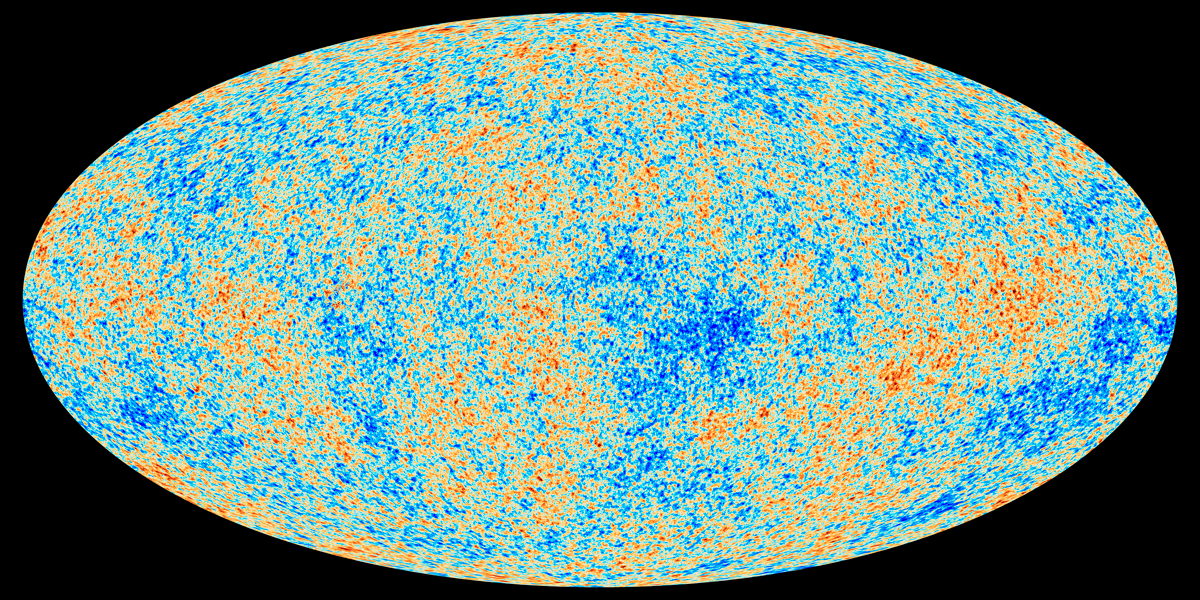
When the universe was about 380,000 years old it had cooled to about 3000 K, cool enough for electrons to attach to nuclei and form atomic matter in highly excited states. This produced a massive flux of photons near the visible range (typical of excited atoms) that filled the early universe. As the universe and space itself expanded, the wavelength of this light was stretched into the microwave range to become the Cosmic Microwave Background (CMB) that Penzias and Wilson inadvertently discovered in 1964.
George Gamow had predicted that a Big Bang should produce just such a background radiation, and the CMB became one of the first pieces of evidence supporting the Big Bang Theory. Since then, the study of the CMB with space-based instruments like COBE, WMAP, and now the Planck Spacecraft continues to be a rich source of information about the early universe and it’s deepest structure.
End of the Dark Age: The First Stars are Born

After about 400 million years of expansion following the Big Bang the universe was cool enough for gravity to begin coalescing clouds of hydrogen into stars, igniting nuclear fusion for the first time. The prodigious outpouring of radiation from the first stars marked the end of the Dark Age, and ionized nearby clouds of hydrogen. This re-ionization is the fingerprint of the first stars and can be seen in the spectral signatures of quasars, in the polarization of the CMB, and in the 21-centimeter emission line of hydrogen.
The birth of the first stars marked a turning point in the life of the universe: from here on the universe took on the features we see today, with galaxies full of stars surrounded by planetary systems. Stars perform some of the most important work in the cosmos: they manufacture the elements heavier than hydrogen, they create planets as part of their own formation, and they provide energy for those planets, as our own Sun does for us. We love stars!
Get the world’s most fascinating discoveries delivered straight to your inbox.
The Solar System Forms: Unusual or Not?

Yellow, G-class stars like the sun are a dime a dozen throughout the universe, but only a fraction of them exist as single stars and contain all 92 naturally occurring elements like our sun. Astronomers now have strong evidence from exoplanet research that virtually all stars form planetary systems as a natural part of their own formation, and this agrees with current theories of star formation. But most of the planetary systems observed so far seem weird and inhospitable for life — for example, with planets the size of Jupiter orbiting much closer than Mercury orbits the sun, or five planets packed into a space smaller than Mercury's orbit. Astronomers have yet to see a solar system that is neatly ordered like our own with a nice rocky planet located in the sweet spot for liquid water and life.
Just how special is Earth's situation?
The media was recently abuzz when researchers estimated (PNAS, Nov. 26, 2013) that there could be 8 billion or 9 billion stars in our galaxy with Earth-like planets — about 5 percent of stars — making the odds very high for intelligent life elsewhere. Yet no life, or evidence of it, has ever been found beyond Earth, so the jury is still very much out on the questions of how rare or common the Earth is, and how unique humanity may or may not be.
Life Begins
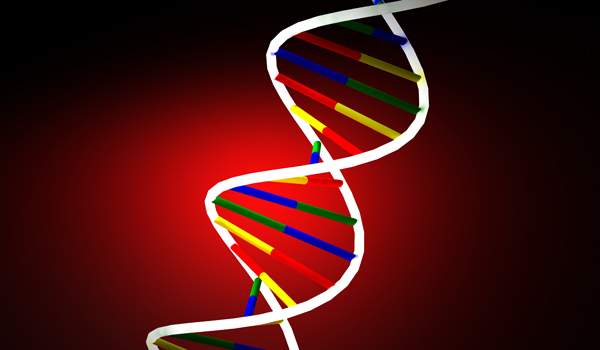
The presence of Carbon-12 in ancient rocks suggests that life began on Earth about 3.8 billion years ago. This means that DNA or some precursor molecule had assembled and could begin its relentless self-replication that drove the evolution of life. But how did such a fragile and complex molecule assemble?
Organic molecules have now been seen throughout the universe. They can be found in the spectral signatures of stars and gas clouds, and the Murchison meteorite that fell to Earth in 1969 contained 92 different amino acids, most never seen on Earth. However it’s a giant leap from amino acids to a living organism with a metabolic system that provides energy, and a genetic system that stores information, directs the construction of proteins, regulates every function of the organism, and replicates itself, all enclosed within a membrane.
Could life have been seeded from elsewhere? Or maybe it was just the chance sloshing together of molecules that was bound to happen somewhere. Or could there be some fundamental organizing principle in the universe that drives matter toward complexity? We don’t know the answer, and the origin of life remains one of the greatest mysteries in all of science.
The Great Oxygen Catastrophe, Snowball Earth, and the Birth of Eukarya

Life on Earth faced its biggest survival crisis about 2.5 billion years ago when the atmosphere changed over from being carbon dioxide-dominant to oxygen-rich. Up to this time life was prokaryotic, or bacteria-like, and thrived on CO2. But photosynthesizing bacteria used up CO2 and produced poisonous O2 that eventually filled the atmosphere. To make matters worse the drop in atmospheric CO2 plunged the earth into a massive deep freeze that has come to be called the Snowball Earth Event. Our planet was covered entirely with thick sheets of ice except near the equator, and life in the dark oceans was nearly driven to extinction. Yet somewhere in the midst of this two-headed crisis a new and more complex form of life emerged: Eukarya.
In 1967 Lynn Margulis was the first to recognize that some prokaryotic organisms were able to merge together in a cooperative arrangement she named endosymbiosis that helped them survive the crisis. We now understand that the mitochondria in animal cells and the chloroplasts in plant cells were once individual organisms before they were engulfed to become Eukaryotic organelles. They still carry primitive genomes from their days as prokaryotes. The emergence of Eukaryotic life opened the door for all higher forms of life that would follow – including us!
Lucky for Us: The Cretaceous-Tertiary (KT) Extinction
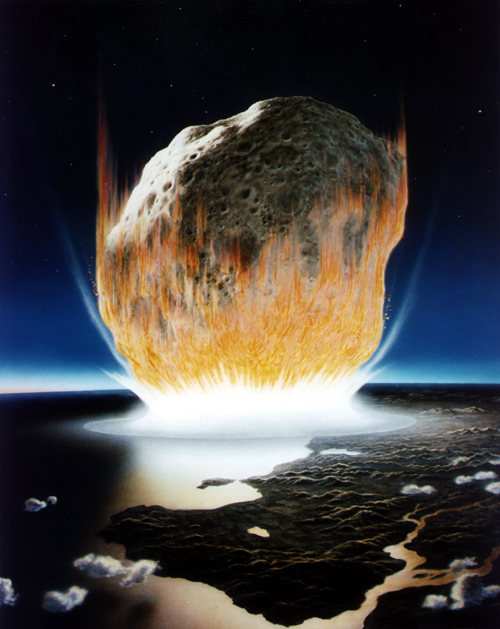
For nearly 200 million years dinosaurs ruled the Earth. Then quite suddenly, about 65 million years ago, they disappeared. It was Luis and Walter Alvarez, father and son, who first explained in 1980 what happened to the dinosaurs. They found thin layers of iridium in rocks that dated to 65 million years ago, and since iridium is naturally very rare on Earth they proposed that it’s source was a meteorite that impacted the Earth at this time. Their theory was controversial at first and had many doubters, but other researchers began to find similar iridium layers in rocks from other locations on Earth, suggesting a global event, and finally a meteor crater was found near the Yucatan Peninsula that was to about the same age.
The Chicxulub meteor must have been 10 to 15 kilometers in size and traveling at about 10,000 mph when it impacted, triggering a global winter that was devastating for nearly all land plants and animals. But the small furry mammals that burrowed underground survived. They had been living in the shadows of the dinosaurs all along, but with the dinosaurs gone they could now thrive and grow in size. They became the new rulers of the Earth. Eventually the mammalian lineage evolved into primates, then apes, then hominids, and finally the Homo lineage that produced human beings. If not for the chance encounter with a meteor 65 million years ago it is doubtful whether we would be here at all.
Tool Time: The Emergence of Homo

By about 5 million years ago certain apes in Africa had mastered the art of upright walking – these were the hominids. For the next few million years they roamed Africa as Australopithecus, with at least 7 different member species. But sometime about 2.5 million years ago, a new lineage branched off from Australopithecus. This is now called the genus Homo. There is still considerable debate about how and when this divergence happened, and which hominid species were involved. But the most widespread view is that Homo habilis was the first member if this new lineage, and by about 2.0 million years ago an ancestor that we now call Homo erectus was thriving in East Africa and would soon begin to populate Eurasia and Asia.
Stone tools also appear in the fossil record for the first time about 2.5 million years ago near the fossil remains of early members of Homo. No other life form had ever manufactured and used stone tools, and passed along the art for many generations. This was the birth of true culture and the advent of technology. Paralleling the development of tools was a rapid expansion in brain volume, eventually tripling in Homo neanderthalensis and Homo sapiens by about 200,000 years ago. But the Neanderthals seemed to stall out in their development of technology, while Homo sapiens continued to evolve technology, culture, and consciousness, turning us into a near-geologic force on the Earth. In the end, every hominid species went extinct – except one. We are the last and only surviving hominid.
Friend or Foe: Who were the Neanderthals?
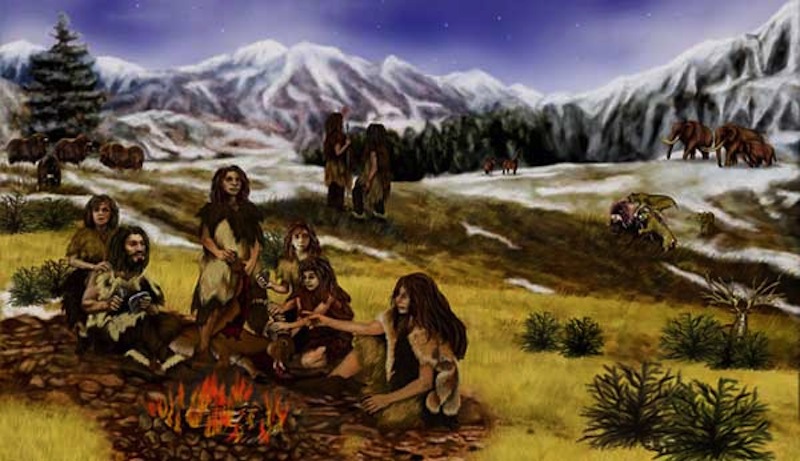
By perhaps 1 million years ago, the hominid living in Africa called Homo ergaster (also called Homo erectus) began evolving into a new species. This was Homo heidelbergensis, probably humanity's most immediate ancestor. Some members of this new species stayed in Africa, while others exited Africa and made their way into Europe, where they show up in the fossil record by about 800,000 years ago. The European heidelbergensis population, adapting to the much colder conditions, evolved into Homo neanderthalensis by about 400,000 years ago.
The Neanderthals, who were large-brained and very intelligent, spread all over Central Asia and Europe, while their cousins who had stayed in Africa evolved into modern humans, Homo sapiens. By about 100,000 years ago, humans began to leave Africa for the first time, putting them on a collision course with the Neanderthals, first in Central Asia and later in Europe. They interacted mysteriously in ways that are not yet fully understood.
In the end, by about 30,000 years ago, the Neanderthals retreated to Spain and Portugal, where they finally went extinct. There is no real evidence that humans killed the Neanderthals, and the similarity in their tools suggests some overlapping of cultures. But recently published genomic studies by Svante Pääbo of the Max Planck Institute and his colleagues reveal that some people of European descent today carry as much as 4 percent Neanderthal DNA, leaving no doubt that the two populations interbred somewhere along the way.
The Great Leap Forward

Jared Diamond popularized this descriptor in his book The Third Chimpanzee (1992), and Richard Klein called this phenomenon the “big bang of human culture” in The Dawn of Human Culture (2002). Archeologists have strong evidence from the tool culture that points to an astounding leap in human intelligence between about 100,000 and 60,000 years ago.
Curiously, geneticists have also found that at about this time the total human population on Earth plummeted to perhaps just a few thousand individuals. It is not known exactly what caused this population bottleneck, but it would be impossible to ignore the eruption of Mount Toba 73,000 years ago on the island of Sumatra. This was the largest volcanic event in the last 30 million years, depositing 30-foot thick layers of ash in India and triggering a global winter that may have lasted for a thousand years.
It seems that the humans living in East Africa who survived the Toba event were a new and better version of Homo sapiens, perhaps capable of spoken language and the powers of collaborative culture that it bestowed. These new humans, sometimes called behaviorally modern humans, were soon able to leave Africa and spread to every habitable continent on the Earth in a relatively short time, pushing the Neanderthals and all other remaining hominid species to extinction. No other living thing has had a fair chance to compete with us ever since the Great Leap.
The Advent of Civilization

For more than 2 million years our ancestors were nomadic hunter-gatherers. This changed for the first time about 11,500 years ago as Earth’s climate became warmer and milder.
People in the Middle East began experimenting with edible plants, selecting seeds from the best plants and planting them in protected areas. This type of gardening, called horticulture, required that people remain in one place to tend their crops, and gradually the nomadic lifestyle was replaced by more sedentary, permanent camps. Animals, too, were domesticated as companions, servants, or food sources. By about 10,000 years ago large permanent settlements like Jericho and Catalhoyuk appear in the archeological record. These “proto-cities” were not yet true cities but more like disorganized collections of villages with few signs of warfare, social stratification, wealth, rulers or any other levels of status. But another shift in human development on par with the Great Leap was in store.
By about 5200 years ago the first city-states first appear in several locations throughout the Middle East. For the first time the archeological record shows clear evidence of social stratification and a ruling elite holding almost all the wealth and power. This was the advent of civilization.
With the invention of writing human knowledge could be recorded permanently and controlled. Most of the characteristics of the today’s world now appeared, including centralized government and power, military forces and warfare, institutionalized religion, patriarchy, monetary systems, poverty, large-scale agriculture, trade networks, and empire. Civilization soon appeared independently at many other locations throughout the world including China, India, Egypt, Peru, Crete, and Mexico. Not much of this has changed in the last 5000 years except the names and places. But is this model still serving us well, or in humanity ready for something new, the next Great Leap?
The views expressed are those of the author and do not necessarily reflect the views of the publisher. This version of the article was originally published on LiveScience.


